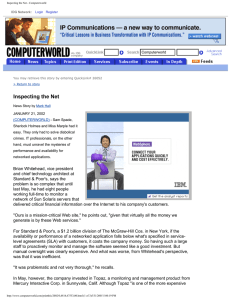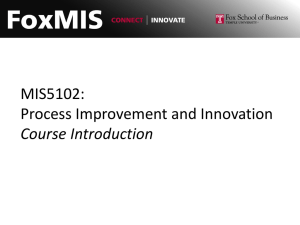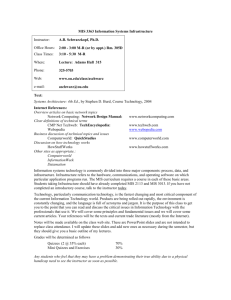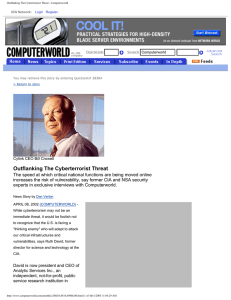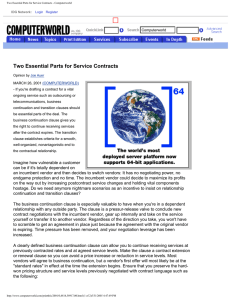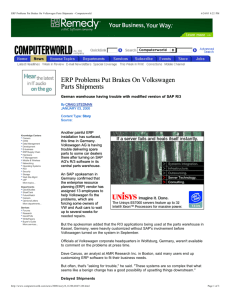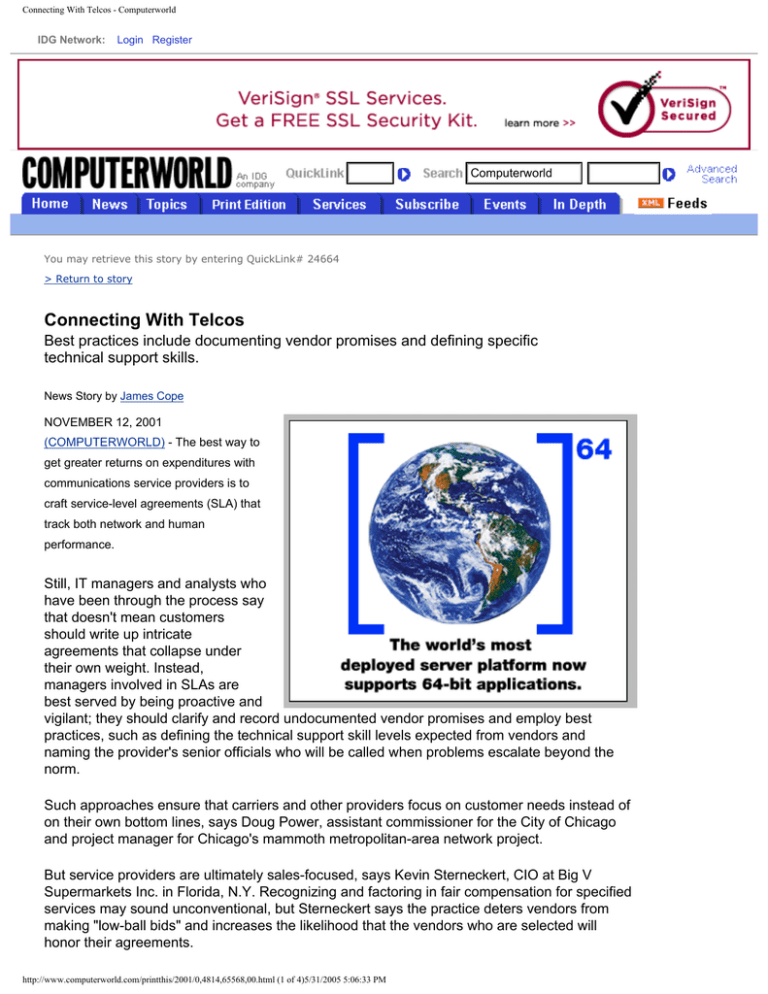
Connecting With Telcos - Computerworld
IDG Network:
Login Register
Computerworld
You may retrieve this story by entering QuickLink# 24664
> Return to story
Connecting With Telcos
Best practices include documenting vendor promises and defining specific
technical support skills.
News Story by James Cope
NOVEMBER 12, 2001
(COMPUTERWORLD) - The best way to
get greater returns on expenditures with
communications service providers is to
craft service-level agreements (SLA) that
track both network and human
performance.
Still, IT managers and analysts who
have been through the process say
that doesn't mean customers
should write up intricate
agreements that collapse under
their own weight. Instead,
managers involved in SLAs are
best served by being proactive and
vigilant; they should clarify and record undocumented vendor promises and employ best
practices, such as defining the technical support skill levels expected from vendors and
naming the provider's senior officials who will be called when problems escalate beyond the
norm.
Such approaches ensure that carriers and other providers focus on customer needs instead of
on their own bottom lines, says Doug Power, assistant commissioner for the City of Chicago
and project manager for Chicago's mammoth metropolitan-area network project.
But service providers are ultimately sales-focused, says Kevin Sterneckert, CIO at Big V
Supermarkets Inc. in Florida, N.Y. Recognizing and factoring in fair compensation for specified
services may sound unconventional, but Sterneckert says the practice deters vendors from
making "low-ball bids" and increases the likelihood that the vendors who are selected will
honor their agreements.
http://www.computerworld.com/printthis/2001/0,4814,65568,00.html (1 of 4)5/31/2005 5:06:33 PM
Connecting With Telcos - Computerworld
SLAs are about keeping promises, Power says. He says the degree to which a service
provider keeps its promise is directly proportional to the technical talent of the staff a vendor
assigns to the customer's service team. That's why he advises managers to detail the skill
levels that a vendor promises and include the head count assigned to the customer in the
SLA.
Still, holding vendors to those commitments can be an ongoing adventure, Power warns.
"Simply because a service provider has the techies now, doesn't mean they'll have them in the
future," Power says.
In addition, IT managers should ask what they're measuring before working specific
performance criteria into SLAs, says Lisa Pierce, an analyst at Giga Information Group Inc. in
Cambridge, Mass. Case in point: Long-distance providers may report on performance within
their own networks but not necessarily for other providers with which they connect. She also
cautions managers to say no to murky language in SLAs. "Averages across a provider's entire
frame-relay system, for example, are useless," Pierce notes.
Sterneckert has figured a way to both mitigate measurement
SLA Best Practices:
problems and discourage vendor finger-pointing. For instance, he What to do when a service
has split his company's data networking and some voice services provider can't meet the terms
between two different providers. AT&T Corp. handles Big V's
of an SLA
frame-relay connections between its headquarters and 31 stores Connecting With Telcos
and the packet-based voice services among those sites. A
separate SLA with WorldCom Inc. handles teleconferencing services and all long-distance
calls made over public voice networks.
While Sterneckert holds quarterly meetings with AT&T and WorldCom to discuss their
performance against their respective SLAs, he has also developed his own proprietary
process for tracking uptime for the frame-relay circuits his company uses.
"We compare our measurements to reports provided by AT&T," he says. "Typically, we don't
find a major difference, but when we do, we figure out what's going on and work through the
differences."
12 Ways to a Better SLA
1. Go for shorter contract periods, with options to renew.
2. Determine if the vendor can make a profit on your contract without betting on business that’s yet to come.
3. Request that the network under the SLA covers interconnected networks owned and operated by other carriers;
otherwise, create multiple SLAs specifying who’s responsible for what.
4. Define the number and specific skills of the vendor’s technicians who will be available to support the SLA and
where they will be located.
5. List the names and numbers of senior service provider officials you can call when problems escalate.
6. Conduct monthly or quarterly vendor meetings to review performance against the SLA to make sure you’re both
on the same page.
7. Have a backup plan for network outages.
8. Determine what will be measured, how it will be measured, and who will measure it.
9. Have a transition clause and process in place in case you need to switch to another provider.
10. Define potential problems upfront and create a timetable for the vendor to fix them.
11. Determine fines, reimbursements or other natural consequences if the provider doesn’t meet service levels.
12. Determine which repair or replacement parts should be available within an hour.
http://www.computerworld.com/printthis/2001/0,4814,65568,00.html (2 of 4)5/31/2005 5:06:33 PM
Connecting With Telcos - Computerworld
BY THE NUMBERS
Still Struggling With the Math
How do you measure the success of technology spending?
Base: 50 IT executives at Fortune 1,000 companies. Multiple
responses accepted.
Source: Forrester Research inc., Cambridge, Mass., 2001
Lucrative ASPirations
ASP implementations generated an average five-year ROI of
404%.
57% of companies experienced ROI greater than 100%.
12% of companies reported ROI greater than 1,000%.
The average payback for ASP outsourcing was 1.33 years on an
average total investment of $4.2 million. The average initial
investment was $400,000.
Base: 53 companies using ASP-delivered application services
Source: IDC, Framingham, Mass., 2001
The CEO Perspective
After the Sept. 11 attacks,
58%
haven’t changed hiring, layoff or expansion plans
62%
haven’t changed corporate travel policies
66%
don’t plan to change corporate security policies
73%
expect attacks to delay economic recovery
expect the economy to rebound during the first half
53%
of next year
Base: 1,366 CEOs of midsize companies
Source: TEC International, San Diego
http://www.computerworld.com/printthis/2001/0,4814,65568,00.html (3 of 4)5/31/2005 5:06:33 PM
Connecting With Telcos - Computerworld
Copyright © 2005 Computerworld Inc. All rights reserved. Reproduction in whole or in part in any form or medium without express written permission of
Computerworld Inc. is prohibited. Computerworld and Computerworld.com and the respective logos are trademarks of International Data Group Inc.
http://www.computerworld.com/printthis/2001/0,4814,65568,00.html (4 of 4)5/31/2005 5:06:33 PM

